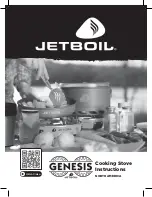
Hearthstone Quality Home Heating Products, Inc
®
Bari Model 8171
36
MEDIUM HIGH BURN:
With the primary air control
in the open position, push the control handle slightly
towards the firebox, or about ¼ to ½ the way in.
MEDIUM LOW BURN:
With the primary air control
in the open position, push the handle inward about
¾ of the way in. A medium-low burn rate is the typical
setting and is preferable if the stove is unattended.
LOW BURN:
Push the primary air control inward all
the way to the firebox. This closes the air shutter to
its minimum opening. A low burn rate over extended
periods is not advisable as it can promote the
accumulation of creosote. Inspect the venting
system frequently if using low burn rates
consistently.
C
ATALYTIC
C
OMBUSTOR
O
PERATION
The BARI uses a catalytic combustor to ensure
highly clean and efficient burns. The catalytic
combustor is made from a stainless steel
corrugation that is coated with a catalytic material.
The catalytic combustor becomes active around
500
⁰
F (260
⁰
C), helping to burn up smoke and any
remaining particles that were not fully burned in the
firebox. During the startup of a cold stove, a
medium to high firing rate must be maintained for
about 20 minutes. This ensures that the stove,
catalysts, and fuel are all stabilized and at proper
operating temperatures. Even though it is possible
to have gas temperatures reach 500 °F (260
⁰
C)
within 2 to 3 minutes after a fire is started, if the fire
is allowed to die down immediately, it may go out or
the combustor may stop working. Once the stove
and catalytic combustor heat up, heat generated
from burning smoke keeps the catalysts warm and
active as long as fuel remains in the stove. You
stove will burn the cleanest and most efficiently
when the catalysts are in the active range. There
should be little to no visible smoke from your
chimney when the catalysts are in the active zone
and fully functional.
O
VER
-F
IRE
C
AUTION
Over-firing means the stove is operating at
temperatures above the recommended
temperatures outlined in the
BURN RATE
section.
Carefully avoid over-firing, as it will damage the
stove. Symptoms of chronic over-firing can include
warped components, short burn times, a roaring
sound in the stove or stovepipe, and discoloration of
the stovepipe.
Excessive draft, inappropriate fuel, and operator
error can cause over-firing. Correct an over-fire
situation as follows:
•
EXCESSIVE DRAFT:
Contact your local dealer
to have a draft reading taken. Any draft in excess
of -0.1 WC requires a damper in the stovepipe.
Some installations may require more than one
damper.
•
INAPPROPRIATE FUEL:
Do not burn coal; kiln
dried lumber, wax logs or anything other than
natural cordwood.
•
OPERATOR ERROR:
Ensure all the gaskets
are in good condition. Replace worn out or
compressed gaskets. Do not burn the stove with
the front door, ash pan, or the ash grate in the
open position.
If you suspect that your stove is over-firing, contact
your dealer immediately.
Damage caused by over-
firing is not covered by your warranty.
Results of
over-firing can include warped or burned out internal
parts, cracked vermiculite panels, discolored or
warped external parts, and damaged finish.
R
EMOVAL
A
ND
D
ISPOSAL
O
F
A
SHES
Remove ashes only when the stove is cold. Use
protective fireplace gloves if the ash pan is warm.
Exercise extreme caution when handling, storing or
disposing of ashes.
The ash pan is located behind the control door. The
ash pan collects burned ash from a fire and allows
you to remove the ash conveniently from your wood
stove. Clear the firebox of ashes often, and do not let
them build up more than 3 inches high. It is important
to prevent ashes from building up around the front
door opening. To remove ashes, pull the grate lever
out to open the grate. Sift the ashes across the grate
into the ash pan. Then return the ash grate to its
closed position by pushing the lever back in towards
the stove. The ash pan is easy to remove and has a
handle and lid for convenient disposal of ashes. The
lid must be stored under the ash pan when burning
the stove. The ash pan will not seal properly without
the lid under it.
Dump ashes from the ash pan directly into a
metal
container with a tight fitting lid and move outdoors
immediately. Do not place any other items or trash
into the metal container. Do not pour water into the
container. Replace the container’s lid and allow the
ashes to cool. Never place the ash disposal
container on a combustible surface or vinyl flooring,
as the container could be
hot!
















































